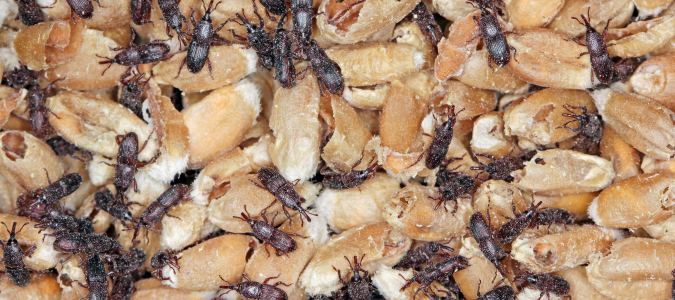Wheat weevils are pesky pantry pests that can ruin a good box of cereal. As their name suggests, these tiny bugs feast on and live in wheat. They reside in pantries and cupboards where they can access dry foods.
These small pests, which are technically beetles, contaminate food and can become a major headache for homeowners. They reproduce rapidly, meaning a small wheat weevil problem can become a big infestation in no time.
The best thing homeowners can do is educate themselves about wheat weevils so that they can deter them from their kitchens.
If you have wheat weevils in your pantry or kitchen cabinets, the best thing you can do is contact a pest control expert. Using a professional service is the best way to control the infestation.
Wheat Weevil: Identification & Control Guide
Wheat weevils are tiny beetles that typically live in pantries or cabinets. A wheat weevil infestation can become a big problem for homeowners if left unchecked. It’s important to understand their appearance, behavior, diet and habitat to control an infestation effectively.
Wheat Weevil Appearance
Wheat weevils are tiny reddish brown or black pests. They measure between two and four millimeters long and are most recognized for their elongated snouts.
The snouts serve an important function: wheat weevils use them to puncture through grains and lay their eggs inside them. Then, the eggs hatch in to larvae that feed off the grains.
Wheat weevil larvae look like tiny legless grubs. They have a humpback and are white with a tan head. As they mature into adulthood, they develop three pairs of legs and elbowed antennae. Most wheat weevils do not have wings. However, some types do have wings but cannot fly.
Wheat Weevil Behavior
Wheat weevils are nocturnal and prefer to live in dark areas where they can be left undisturbed. Homeowners often find them in their cereal boxes, rice bags and inside other grain containers.
These pests use the grains to lay their eggs. First, a female wheat weevil will chew through the grain before depositing her egg. After laying the egg, she will seal the grain by secreting a gelatinous substance on top of the egg.
When threatened, adult wheat weevils will play dead by pulling their legs into their bodies.
Wheat Weevil Diet and Preferred Habitat
As their name suggests, wheat weevils feed on wheat, specifically cereal grains. They are attracted to rice, barley, oats and corn. Homeowners may also find them in their pasta, flour or birdseed containers.
When it comes to a place to live, wheat weevils prefer pantries and kitchen cabinets because they are dark and humid. However, some wheat weevils will live outside and cause significant damage to wheat and grain crops.
How To Deter Wheat Weevils
The best way to deter wheat weevils is by keeping your kitchen clean. Regularly wipe down surfaces in your pantry and cupboards and discard spilled food. Store your grains and cereals in airtight containers made of sturdy material, such as glass, metal or thick plastic.
Since wheat weevils prefer warm habitats, keeping your pantry cool is an effective way to deter them from your kitchen. Another strategy is refrigerating your dry foods for a few days before storing them in an airtight container in your pantry or cupboard.
Wheat weevils are more likely to infest older food, so it’s important to use up your older food before opening something new. Try organizing your pantry so that the oldest food is in the front so it doesn’t get lost on the back of a shelf.
Homeowners can easily use caulk to fill in cracks and ensure screens and doors have a tight fit to reduce the amount of wheat weevils that can enter their home. These steps are helpful in the fight against other pests, too. For example, taking these steps can help with cockroach prevention.
How To Get Rid of Wheat Weevils
When you spot wheat weevils in your food, discard the entire container. Next, inspect the rest of your pantry goods for more pests.
Vacuum out your pantry and cupboard shelves to remove any stray wheat weevils. Afterward, wipe down the shelves with a cloth.
The most effective way to thoroughly get rid of a wheat weevil infestation is through professional methods. Contact an expert pest control service as soon as you spot these unwanted visitors in your pantry. A pest control specialist can also provide ongoing pest treatments, so you’re less likely to deal with these pests in the future.
The Wheat Weevil Life Cycle
The wheat weevil life cycle has four stages: egg, larvae, pupae and adult. Eggs are hatched into pieces of grains and look like tiny white ovals. Once they hatch, they move into the larvae stage and immediately start eating the inside of the grain kernel.
The larvae stage lasts four to five weeks before the wheat weevils become pupae. During the pupal stage, the wheat weevils rest in a cocoon-like structure while they grow into adults.
The cocoon, also called a pupa, is yellow or white and can easily hide among the grains. This stage lasts one to two weeks before the wheat weevils emerge as adults.
Adult wheat weevils start reproducing a few days after they emerge from their pupa, and the life cycle starts over again. Wheat weevils reproduce rapidly, with female wheat weevils laying between 250 and 400 eggs in their lifetime. Adult wheat weevils live for up to eight months.
Since they reproduce so quickly, a small wheat weevil infestation can quickly become a major annoyance for homeowners. It’s important not to ignore these tiny pests and act as soon as you discover them.
Calling in a pest control expert is the best way to control wheat weevils and learn about prevention methods that can help deter them in the future.
Do Wheat Weevils Bite?
There are several myths about whether or not wheat weevils bite. The truth is that these pests do not bite humans. However, their long snouts make it easy to assume they could bite when threatened.
These tiny pests have no interest in human blood. Instead, they spend their lives eating grains and trying to stay out of sight.
Even though they don’t bite, wheat weevils can still cause problems for homeowners. The main problem is that they contaminate food when they live inside a pantry or cupboard.
The quality of the food that wheat weevils touch significantly declines and must be thrown out. This leads to product loss, financial loss and food waste. Unfortunately, wheat weevils are the most destructive pests that threaten grains.
More Wheat Weevil Prevention Tips
There are several things that homeowners can do to keep wheat weevils out of their kitchens. In addition to the tips above, keep these additional wheat weevil prevention tips in mind:
- Do not store pantry food in paper or plastic containers. Instead, invest in high-quality food storage containers that wheat weevils cannot get into.
- Regularly inspect your pantry for crevices, cracks and holes that wheat weevils may use to enter your home. Seal up these areas right away.
- Inspect all newly purchased grains for wheat weevils before storing them in your home.
- Purchase grains in smaller quantities instead of buying them in bulk. The faster you eat your pantry food, the less time wheat weevils have to infest your shelves. Buying smaller quantities will help you go through your food faster and prevent these unwanted pantry pests.
Following these tips can help keep wheat weevils away. However, if you still encounter wheat weevils in your home, call a pest control expert. A professional pest service can control the infestation and advise you further on keeping these pests out of your home.
Take Your Pantry Back From Wheat Weevils
There’s nothing like the disappointment of pouring a bowl of cereal and finding wheat weevils in your food. Follow the methods above to keep wheat weevils out of your kitchen. As a reminder, store your grains in solid containers and consider leaving them in the refrigerator for a few days before putting them in your pantry.
If you find wheat weevils in your food, throw out the food right away. Next, give your pantry a thorough cleaning, which includes vacuuming the shelves. Finally, contact a pest control expert to control the infestation.
ABC Can Treat for Wheat Weevils
Wheat weevils can be difficult to control because of how quickly they reproduce. Instead of battling these pests on your own, contact ABC Home & Commercial Services. Our professionals can come up with an effective pest treatment plan, so you can feel comfortable when you go to grab food out of your pantry. Plus, our team can help you get rid of ants, cockroaches and other household pests.



